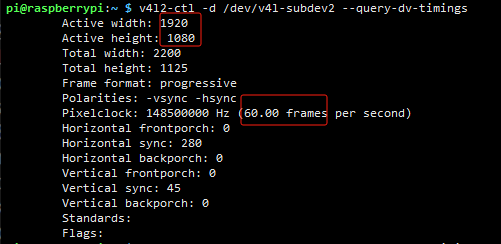CSI Manual on Pi 5
This tutorial is only for C790 and C779. It should be noted that C790 supports audio and supports resolution up to 1080P@60HZ, but C779 does not support audio and the resolution is only 1080P@50HZ
1. Edit /boot/config.txt (sudo permission required).
- sudo nano /boot/config.txt
- Add the following content:
- dtoverlay=tc358743
- If your modules C790 support audio, add the following content to enable audio support. If you use C779, please ignore this step
- dtoverlay=tc358743-audio
- Then reboot the raspberry Pi.
2. Execute the following command to find the media node corresponding to the CSI as media0, under the rp1-cfe (platform: 1f00128000.csi) field:
- v4l2-ctl --list-devices
1 blikvm@blikvm:~ $ v4l2-ctl --list-devices
2 pispbe (platform:1000880000.pisp_be):
3 /dev/video20
4 /dev/video21
5 /dev/video22
6 /dev/video23
7 /dev/video24
8 /dev/video25
9 /dev/video26
10 /dev/video27
11 /dev/video28
12 /dev/video29
13 /dev/video30
14 /dev/video31
15 /dev/video32
16 /dev/video33
17 /dev/video34
18 /dev/video35
19 /dev/video36
20 /dev/video37
21 /dev/media1
22 /dev/media2
23
24 rp1-cfe (platform:1f00128000.csi):
25 /dev/video0
26 /dev/video1
27 /dev/video2
28 /dev/video3
29 /dev/video4
30 /dev/video5
31 /dev/video6
32 /dev/video7
33 /dev/media0
34
35 rpivid (platform:rpivid):
36 /dev/video19
37 /dev/media3
3. Locate the node corresponding to tc358743 as v4l-subdev2, and the pad0 of rp1-cfe-csi2_ch0 as video0:
blikvm@blikvm:~ $ media-ctl -d /dev/media0 -p
Media controller API version 6.1.63
Media device information
------------------------
driver rp1-cfe
model rp1-cfe
serial
bus info platform:1f00128000.csi
hw revision 0x114666
driver version 6.1.63
Device topology
- entity 1: csi2 (8 pads, 8 links)
type V4L2 subdev subtype Unknown flags 0
device node name /dev/v4l-subdev0
pad0: Sink
[fmt:SRGGB10_1X10/640x480 field:none colorspace:raw xfer:none ycbcr:601 quantization:full-range]
<- "tc358743 4-000f":0 [ENABLED,IMMUTABLE]
pad1: Sink
[fmt:unknown/8192x1 field:none]
pad2: Sink
[fmt:SRGGB10_1X10/640x480 field:none colorspace:raw xfer:none ycbcr:601 quantization:full-range]
pad3: Sink
[fmt:SRGGB10_1X10/640x480 field:none colorspace:raw xfer:none ycbcr:601 quantization:full-range]
pad4: Source
[fmt:SRGGB10_1X10/640x480 field:none colorspace:raw xfer:none ycbcr:601 quantization:full-range]
-> "rp1-cfe-csi2_ch0":0 []
-> "pisp-fe":0 []
pad5: Source
[fmt:unknown/8192x1 field:none]
-> "rp1-cfe-embedded":0 []
pad6: Source
[fmt:SRGGB10_1X10/640x480 field:none colorspace:raw xfer:none ycbcr:601 quantization:full-range]
-> "rp1-cfe-csi2_ch2":0 []
-> "pisp-fe":0 []
pad7: Source
[fmt:SRGGB10_1X10/640x480 field:none colorspace:raw xfer:none ycbcr:601 quantization:full-range]
-> "rp1-cfe-csi2_ch3":0 []
-> "pisp-fe":0 []
- entity 10: pisp-fe (5 pads, 7 links)
type V4L2 subdev subtype Unknown flags 0
device node name /dev/v4l-subdev1
pad0: Sink
[fmt:SRGGB16_1X16/640x480 field:none colorspace:raw xfer:none ycbcr:601 quantization:full-range]
<- "csi2":4 []
<- "csi2":6 []
<- "csi2":7 []
pad1: Sink
[fmt:FIXED/8192x1 field:none]
<- "rp1-cfe-fe_config":0 []
pad2: Source
[fmt:SRGGB16_1X16/640x480 field:none colorspace:raw xfer:none ycbcr:601 quantization:full-range]
-> "rp1-cfe-fe_image0":0 []
pad3: Source
[fmt:SRGGB16_1X16/640x480 field:none colorspace:raw xfer:none ycbcr:601 quantization:full-range]
-> "rp1-cfe-fe_image1":0 []
pad4: Source
[fmt:FIXED/8192x1 field:none]
-> "rp1-cfe-fe_stats":0 []
- entity 16: tc358743 4-000f (1 pad, 1 link)
type V4L2 subdev subtype Unknown flags 0
device node name /dev/v4l-subdev2
pad0: Source
[fmt:RGB888_1X24/640x480 field:none colorspace:srgb]
[dv.caps:BT.656/1120 min:640x350@13000000 max:1920x1200@165000000 stds:CEA-861,DMT,CVT,GTF caps:progressive,reduced-blanking,custom]
[dv.detect:BT.656/1120 1920x1080p24 (2750x1125) stds: flags:]
[dv.current:BT.656/1120 640x480p59 (800x525) stds:CEA-861,DMT flags:has-cea861-vic]
-> "csi2":0 [ENABLED,IMMUTABLE]
- entity 18: rp1-cfe-csi2_ch0 (1 pad, 1 link)
type Node subtype V4L flags 0
device node name /dev/video0
pad0: Sink
<- "csi2":4 []
- entity 22: rp1-cfe-embedded (1 pad, 1 link)
type Node subtype V4L flags 0
device node name /dev/video1
pad0: Sink
<- "csi2":5 []
- entity 26: rp1-cfe-csi2_ch2 (1 pad, 1 link)
type Node subtype V4L flags 0
device node name /dev/video2
pad0: Sink
<- "csi2":6 []
- entity 30: rp1-cfe-csi2_ch3 (1 pad, 1 link)
type Node subtype V4L flags 0
device node name /dev/video3
pad0: Sink
<- "csi2":7 []
- entity 34: rp1-cfe-fe_image0 (1 pad, 1 link)
type Node subtype V4L flags 1
device node name /dev/video4
pad0: Sink
<- "pisp-fe":2 []
- entity 38: rp1-cfe-fe_image1 (1 pad, 1 link)
type Node subtype V4L flags 0
device node name /dev/video5
pad0: Sink
<- "pisp-fe":3 []
- entity 42: rp1-cfe-fe_stats (1 pad, 1 link)
type Node subtype V4L flags 0
device node name /dev/video6
pad0: Sink
<- "pisp-fe":4 []
- entity 46: rp1-cfe-fe_config (1 pad, 1 link)
type Node subtype V4L flags 0
device node name /dev/video7
pad0: Source
-> "pisp-fe":1 []
4. To query the current input source information, if the resolution displays as 0, it indicates that no input source signal has been detected. In this case, you should check the hardware connections and follow the steps mentioned above to troubleshoot.
Confirm the current input source information.
v4l2-ctl -d /dev/v4l-subdev2 --set-dv-bt-timings query
Initialize media0.
media-ctl -d /dev/media0 -r
Connect CSI2's pad4 to rp1-cfe-csi2_ch0's pad0.
media-ctl -d /dev/media0 -l ''\''csi2'\'':4 -> '\''rp1-cfe-csi2_ch0'\'':0 [1]'
Configure the media node.
media-ctl -d /dev/media0 -V ''\''csi2'\'':0 [fmt:RGB888_1X24/1920x1080 field:none colorspace:srgb]' media-ctl -d /dev/media0 -V ''\''csi2'\'':4 [fmt:RGB888_1X24/1920x1080 field:none colorspace:srgb]'
Set the output format.
v4l2-ctl -v width=1920,height=1080,pixelformat=RGB3
Capture two frames for testing to verify if tc358743 is functioning properly. Other methods, such as using GStreamer, are not currently available.
v4l2-ctl --verbose -d /dev/video0 --set-fmt-video=width=1920,height=1080,pixelformat='RGB3' --stream-mmap=4 --stream-skip=3 --stream-count=2 --stream-to=hdmiin.yuv --stream-poll
If you have installed a desktop version of Raspberry Pi, you can use ffplay to directly play YUV files.
ffplay -f rawvideo -video_size 1920x1080 -pixel_format bgr24 hdmiin.yuv
On a Windows computer, you can use software like 7yuv to view .yuv files. For the tutorial with an input format of 19201080, you should select BGR888 in the top right corner of 7yuv and set the resolution to 19201080 to view the two frames you just captured.

Enable comment auto-refresher
Anonymous user #1
Permalink |